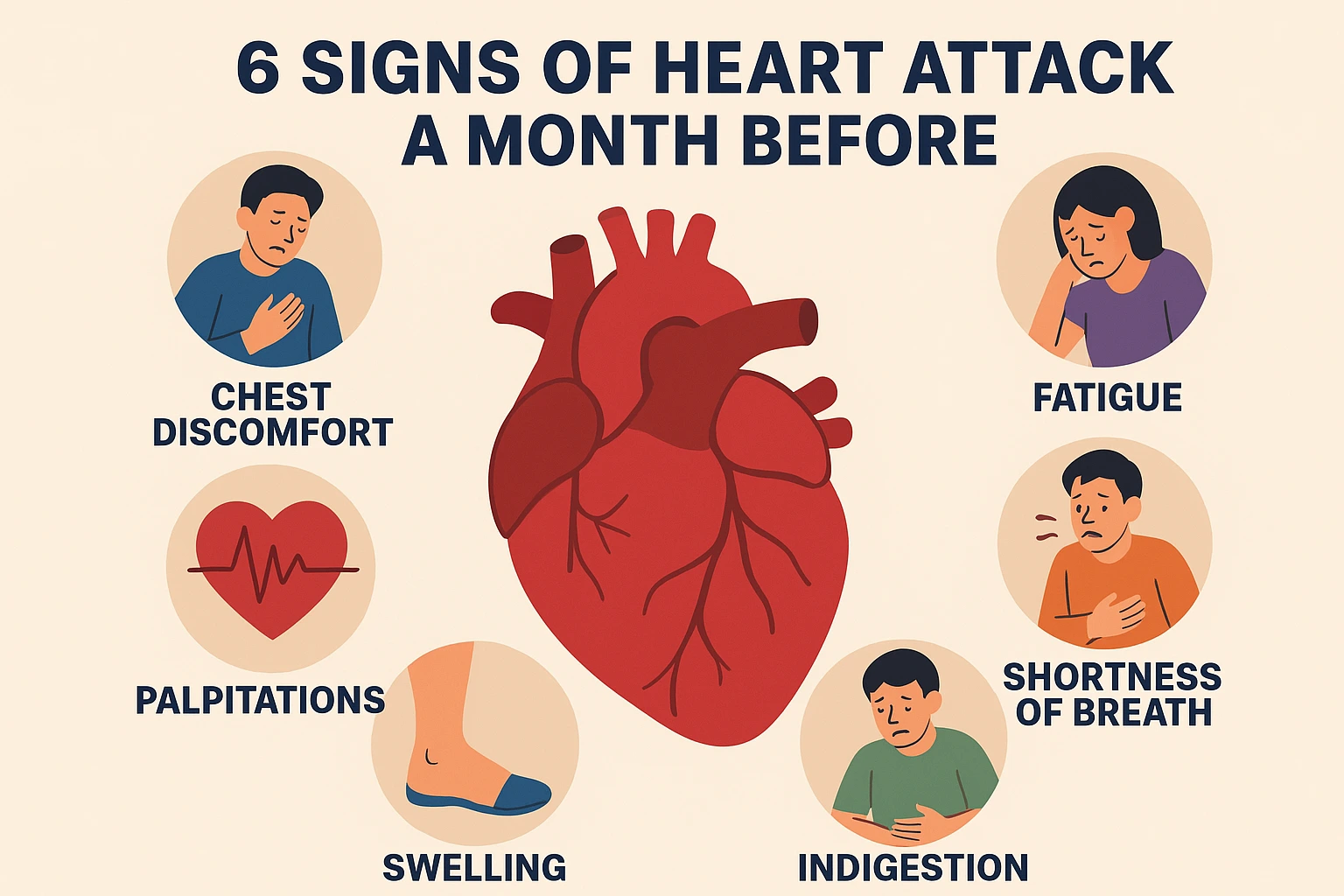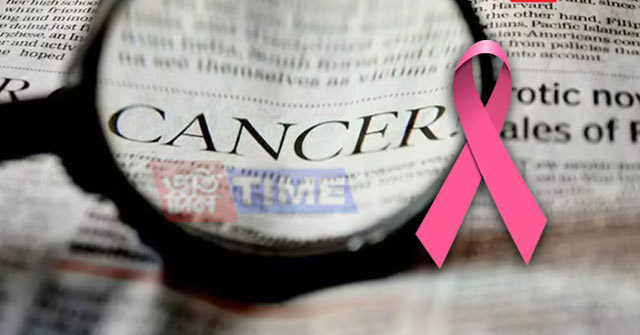One Month Before a Heart Attack, Your Body Will Warn You — These 7 Signs Deserve Attention (Especially the 6th)
By: Javid Amin | 21 November 2025
An in-depth, Kashmir-oriented health awareness guide
Heart Attack in Kashmir: A Growing Health Concern
Some regions carry an invisible weight on their shoulders. Kashmir is one of them.
Snow-covered winters, high altitude terrains, stress-laden routines, dietary patterns rich in salt and fats, and limited access to immediate tertiary healthcare combine into a silent but serious issue—increasing heart disease risk.
Over the past decade, regional health studies and hospital records in Kashmir have repeatedly highlighted:
-
Higher rates of hypertension
-
Increased cases of cholesterol imbalance
-
Rising stress-related disorders
-
Early-age cardiovascular incidents in men and women
-
Lifestyle changes influenced by modernization and reduced physical activity
While global research shows that heart attacks rarely strike “out of nowhere,” many people in Kashmir (and similar regions) ignore early signals—mistaking them for cold weather discomfort, gastric issues, or simple tiredness.
This article aims to provide a simple, human-centered guide to recognize these signals early.
Why Our Bodies Give Signals Weeks Before a Heart Attack
Most heart attacks happen due to a sudden blockage in coronary arteries. But the process that leads to this moment is slow, sometimes taking months or years.
When blood flow to the heart becomes restricted, the body tries to alert us.
Why do symptoms appear a month earlier?
-
Reduced oxygen supply affects organs
-
Nerves react to stress and inflammation
-
Blood pressure and circulation patterns change
-
The body attempts compensation through breathing and fatigue signals
Think of it like a warning system—subtle, gentle, but persistent.
In Kashmir, where cold weather naturally tightens blood vessels and increases blood pressure, these signals can appear even earlier. Unfortunately, many dismiss them as:
-
“Sardi ki wajah se hai.”
-
“Dhadkan toh thand mein tez hoti hi hai.”
-
“Gastric lag raha hai.”
This cultural normalizing of symptoms leads to late detection.
Kashmir’s Lifestyle, Weather & Culture: How They Influence Heart Health
Understanding signals becomes easier when we understand the environment.
Cold Winters
Kashmir’s harsh winters have measurable physiological impacts:
-
Blood vessels constrict
-
Blood thickens
-
Heart works harder
-
High risk for people with hypertension
Dietary Patterns
Traditional Kashmiri cuisine—rich in fats, salt, and spices—can contribute to cardiac strain if not balanced.
-
Wazwan dishes
-
Noon chai (salty pink tea) multiple times a day
-
High rice consumption
-
Frequent red meat intake
While culturally significant, these foods require moderation.
Altitude
Higher altitude means lower oxygen levels.
This forces the heart to pump harder.
Stress & Uncertainty
Decades of social tension have deeply impacted mental health. Chronic stress is a known contributor to heart disease.
Lifestyle Shift
Old days of walking long distances, farming, and physical labor have shifted toward:
-
Sedentary lifestyles
-
Desk jobs
-
Digital-heavy days
Combined, all these elements shape Kashmir’s unique cardiac health profile.
The 7 Warning Signs One Month Before a Heart Attack
(Detailed, expanded, easy-to-understand Kashmir-friendly explanation)
1. Chest Discomfort: Pressure, Squeezing & Fullness
This is the most classic sign, but in Kashmir it is often misunderstood as:
-
Gas
-
Cold-related tightening
-
Muscle strain
How it feels:
-
Pressure like a kangri being pressed against the chest
-
Tightness as if wearing a very heavy pheran
-
Burning or squeezing
-
Comes and goes
Why it matters:
Chest discomfort indicates the heart muscle is not receiving enough oxygen-rich blood. It may last minutes or appear during exertion—like climbing stairs or walking uphill on a winter morning.
Ignoring it is risky.
2. Shortness of Breath — Even Without Exertion
Imagine breathing in cold winter air that suddenly feels heavier. Shortness of breath before a heart attack feels similar but persists even indoors.
Symptoms:
-
Breathlessness after minimal movement
-
Tightness while lying down (especially at night)
-
Feeling “air hunger”
In Kashmir, elders often dismiss this as:
“Sardi mein saans toh phoolti hi hai.”
But persistent breathlessness, especially when combined with fatigue or chest heaviness, demands attention.
3. Unusual Fatigue: A Silent but Powerful Early Sign
Fatigue is one of the most common early symptoms in Kashmiri women.
How it appears:
-
Feeling drained even after resting
-
Struggling with simple tasks
-
Needing frequent breaks
-
Feeling “empty” of energy
In regions with cold climate, fatigue is often blamed on winter laziness, but heart-related fatigue feels different—a deep exhaustion that stays for days or weeks.
4. Dizziness or Lightheadedness
Often coupled with:
-
Cold sweats
-
Weakness
-
Feeling faint
People describe it as:
“Aankhon ke saamne andhera chha gaya.”
“Pairon mein jaan hi nahi.”
This occurs when blood flow to the brain is reduced because the heart isn’t pumping efficiently.
5. Pain Radiating to Arms, Back, Neck, Jaw, or Stomach
This symptom is often confused with:
-
Frozen shoulder (common in cold regions)
-
Neck stiffness from long winter evenings
-
Gastric pain
-
Toothache
But pain spreading to these areas is a classic cardiac sign.
Radiation patterns differ:
-
Men → Mostly left arm
-
Women → Back, neck, jaw, both arms
Pain may come and go, increasing with movement.
6. Nausea or Indigestion — The Most Overlooked Sign
Kashmiris frequently experience gastric discomfort due to:
-
Heavy meals
-
Spices
-
Irregular eating patterns
-
Winter digestive issues
This is why heart-attack-related indigestion is missed.
How cardiac indigestion feels:
-
Persistent gastric discomfort
-
Burning or heaviness in upper abdomen
-
Nausea without food-related cause
-
Vomiting that doesn’t relieve discomfort
-
A feeling similar to “acidity” but deeper and unusual
This sign becomes especially critical when:
-
Combined with fatigue
-
Occurs with chest pressure
-
Happens repeatedly
This is the one sign most people ignore—yet it can be the earliest warning.
7. Sleep Disturbances: Trouble Falling or Staying Asleep
Many Kashmiris naturally struggle with sleep due to:
-
Cold nights
-
Stress
-
Power cuts
-
Anxiety
But heart-related sleep issues feel different.
Common patterns:
-
Waking up breathless
-
Feeling discomfort while lying flat
-
Insomnia due to unexplained unease
-
Sudden night sweating
-
Feeling restless without stress
This may be the body signaling that circulation and oxygen delivery are compromised.
The Science Behind These Symptoms
Heart attacks usually result from:
-
Plaque buildup
-
Blockage formation
-
Reduced oxygen supply
-
Inflammation
Weeks before the major event, the heart muscles begin to suffer, sending out distress signals through the nervous system.
Why symptoms vary between people:
-
Age
-
Gender
-
Lifestyle
-
Stress levels
-
Diabetes (which can mute pain signals)
-
Weather (cold intensifies symptoms)
Men vs Women: Heart Attack Symptom Differences in Kashmir
Symptom Comparison Chart
| Symptom | Men | Women |
|---|---|---|
| Chest Pain | Classic, intense | Milder or absent |
| Breathlessness | During exertion | Often at rest |
| Fatigue | Less common | Very common (weeks before) |
| Radiating Pain | Left arm, jaw | Back, neck, both arms |
| Indigestion | Rare | Frequent |
| Sweating | Cold sweats | Subtle |
| Sleep Issues | Rare | Common |
Kashmir-Specific Observations:
-
Women often attribute symptoms to household fatigue.
-
Men blame cold weather or stress.
-
Elders assume age-related weakness.
-
Younger people ignore indigestion as “normal ghabraahat.”
These stereotypes delay medical care.
Daily Self-Checklist for Heart Health Monitoring
A simple routine anyone in Kashmir can follow:
-
Energy levels — Am I unusually tired?
-
Breathing — Is breathlessness increasing?
-
Chest sensations — Any new discomfort?
-
Radiating pain — Does pain spread anywhere?
-
Heart rhythm — Palpitations? Irregular beats?
-
Digestive issues — Unexplained indigestion?
-
Sleep quality — Waking up uncomfortably?
-
Swelling — Ankles, feet, or legs?
-
Mood — Increased irritability or anxiety?
-
Daily log — Track symptoms, diet & patterns
This helps detect patterns early.
Kashmir Lifestyle, Diet & Habits: How They Affect Heart Health
Common Risk Factors in Kashmir:
-
High salt intake (noon chai)
-
Frequent red meat consumption
-
Low physical activity during winter
-
Stress and emotional burden
-
Smoking (especially among men)
-
Excessive reliance on bakery foods
-
Vitamin D deficiency due to limited sunlight
Protective Factors:
-
Natural foods
-
Traditional herbal teas
-
Walking culture in rural areas
-
Community support during stress
But modernization and reduced outdoor life weaken these protective factors.
Emotional & Cultural Factors: Stress, Conflict & Health
Long-term uncertainty impacts cardiac health through:
-
Chronic stress hormones
-
Increased blood pressure
-
Sleep disruption
-
Anxiety cycles
Even young people in Kashmir show symptoms of stress-induced heart strain.
Preventive Measures Rooted in Kashmir’s Culture
Simple lifestyle shifts:
-
Reduce noon chai frequency
-
Balance wazwan and red meat meals
-
Incorporate vegetables in winter
-
Use kangri warmth mindfully
-
Take brisk walks even in cold weather
-
Practice breathing exercises
-
Use saffron-infused warm water occasionally (traditional calming tonic)
-
Reduce smoking habits
-
Encourage community health talks
Cultural adjustments make health transitions easier.
Emergency Action Plan for Families in Kashmir
If symptoms occur:
-
Do not wait for them to “settle.”
-
Avoid physical exertion.
-
Call emergency services.
-
Keep aspirin at home (doctor-approved).
-
Help the person remain calm and upright.
Given the region’s terrain, keep ambulance numbers saved and identify the nearest hospital in advance.
Final Takeaway
Heart attack warning signs often begin weeks before the actual event, especially the subtle but critical symptom of nausea/indigestion.
In Kashmir’s climate, culture, and lifestyle, these signs can blend into daily life, making awareness essential.
Early recognition can save lives.
Disclaimer
I am not a medical professional. This article is for general awareness only and must never replace a doctor’s advice, diagnosis, or emergency care. If you or someone around you is experiencing concerning symptoms, seek medical assistance immediately.




